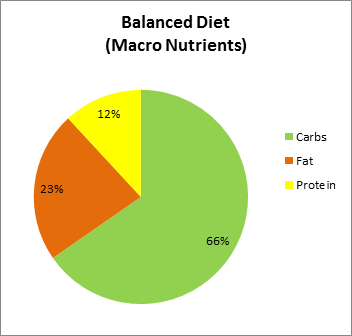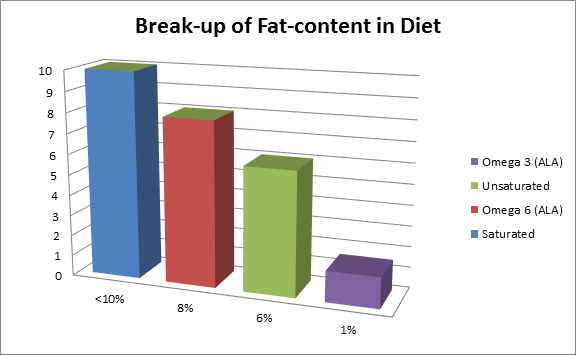
Contents
Overall Dietary Needs
People are quite conscious about their diet. But they may not be aware of the proportion and quantity of various macro- and micro-nutrients. Major nutrients are carbohydrates, fats and proteins. Micro-nutrients are vitamins, minerals and antioxidants. The picture below shows the ideal break-up for calorie-intake in a normal diet.
Persons leading sedentary lifestyle invariably end up taking more fats than required. The fat-content in daily food-intake should not exceed 30%. Second-level break-up for fat intake is given below.

Benefits and Sources of Healthy Fats
When trying to reduce weight, one may cut down on fats but Zero-fat is not advocated at all. Good fat like HDL is required for the functioning of heart and body.HDL is derived from Omega 3 and 6 fatty acids. Omega 6 is commonly found in oils from fish, mustard, olives and sunflower. Omega 3 is found in walnuts, flaxseed and even pumpkin-seeds. As noted in earlier blog dry-fruits are a rich source of good-fat and minerals. Remember to follow the 5-colors-a-day everyday to stay healthy!
Which Oils to Use and How?
Various different oils have their unique good qualities. So it is advised to use a mix of oils for cooking. For best results mix oils rich in PUFA and MUFA in 1:1 ratio.- Oils rich in Poly Unsaturated Fatty Acids (PUFA) – sunflower, safflower, corn
- Oils rich in Mono Unsaturated Fatty Acids (MUFA) – groundnut, soyabean
Finally, pour only enough quantity of oil so as to utilize it completely in one go. Used oil contains more trans-fatty acids which are atherogenic – leading to deposition of fat in arteries. Oils should preferably not be reused.
Hydrogenated oils, used oils should be avoided they increase LDL (bad cholesterol) and decrease HDL (good cholesterol) leading to atherosclerosis.
Visitor Rating: 5 Stars
Visitor Rating: 5 Stars